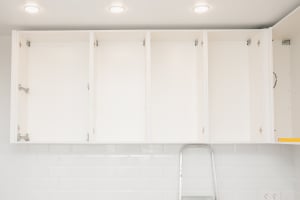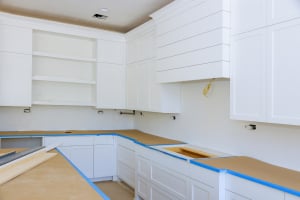Have you ever wondered why bathroom vanities are often lower than kitchen counters? It's a detail that’s sometimes overlooked, yet there is a world of thought behind that seemingly odd measurement. The reasons behind this design detail might surprise you.
Bathroom base cabinets and vanities are typically lower than kitchen countertops because they are designed for tasks done seated or when bending at the waist, such as applying makeup or shaving.
The standard height for bathroom vanities used to be thirty to thirty-two inches (around seventy-six to eighty-one centimeters), which is indeed lower than the standard kitchen counter height of thirty-six inches (approximately ninety-one centimeters). But there’s more to it! Below, we’ll uncover more about why these vanities are lower than kitchen counters.
It’s All About Ergonomics
Ergonomics is the study of people's efficiency in their environment. In the context of a home, it can refer to designing furnishings and fixtures that will be safe and comfortable for the people who use them. Ergonomics play a major role in determining the height of bathroom vanities.
We use a bathroom vanity for washing our hands, brushing our teeth, shaving, and applying makeup. A lower vanity height can make these activities more comfortable, reducing the need to overstretch or awkwardly bend.
A vanity that's too high or too low can cause strain in a person’s back or neck over time. On the other hand, lower bathroom vanities can significantly benefit children by letting them reach the sink, faucet, and countertop area easier. Accessibility can encourage better hygiene habits because children can wash their hands and brush their teeth more independently.
People Got Taller
The heights of bathroom vanities were standardized years ago based on average heights. In the early to mid-twentieth century, when many of these standards were established, the average size of adults was smaller than it is today. For example, in the United States, the average height for men in the 1960s was about five feet and eight inches, and for women, it was around five feet and three inches. Today, average heights have increased to about five feet and nine inches for men and five feet and four inches for women.
Although this might not seem like a significant increase, it does make a difference in comfort and ergonomics. This trend has resulted in a shift towards comfort-height vanities that are typically thirty-six inches high.
Less Water Splashing
A lower sink reduces the distance between the faucet and the sink basin. This can result in less water splashing onto the countertop or the floor. It keeps the bathroom clean and less prone to wet accidents. A lower sink also makes it easier for children to reach the faucet, reducing the chance of them leaving the water running or causing a spill.
Ways to Increase the Height of Your Vanity
If you find that your bathroom vanity is too low for your comfort, there are a few ways you can raise its height yourself.
Add Furniture Risers
Furniture risers are a simple and affordable way to raise the height of your bathroom vanity. These are typically small plastic, or wooden blocks that sit underneath the feet or base of your vanity to lift it up. They're an easy and relatively inexpensive solution, but they may not be the most visually appealing option. However, if your vanity has a toe kick, the risers may not be noticeable.
Stability is vital when using furniture risers. Ensure the risers are level and evenly spaced and that the feet or base of your vanity sit securely on top of them. You can use adhesive or screws to attach the risers to the vanity if needed.
Install a Wooden Base
You can add a wooden base to the bottom of your vanity to raise its height. You can use a piece of plywood or a two-by-four-inch board to create the base. Simply cut the board to size, attach it to the bottom of the vanity using screws or adhesive, and then paint or stain it to match the vanity.
Final Thoughts
Why are bathroom vanities so expensive? They don't need to be. Our team at 27EStore is knowledgeable in all aspects of bathroom vanity design and construction and can work within your budget. We’ll provide expert guidance on choosing suitable materials and installing your vanity!
Wondering if bathroom and kitchen cabinets need to match? We have you covered–take a look at our latest post!













